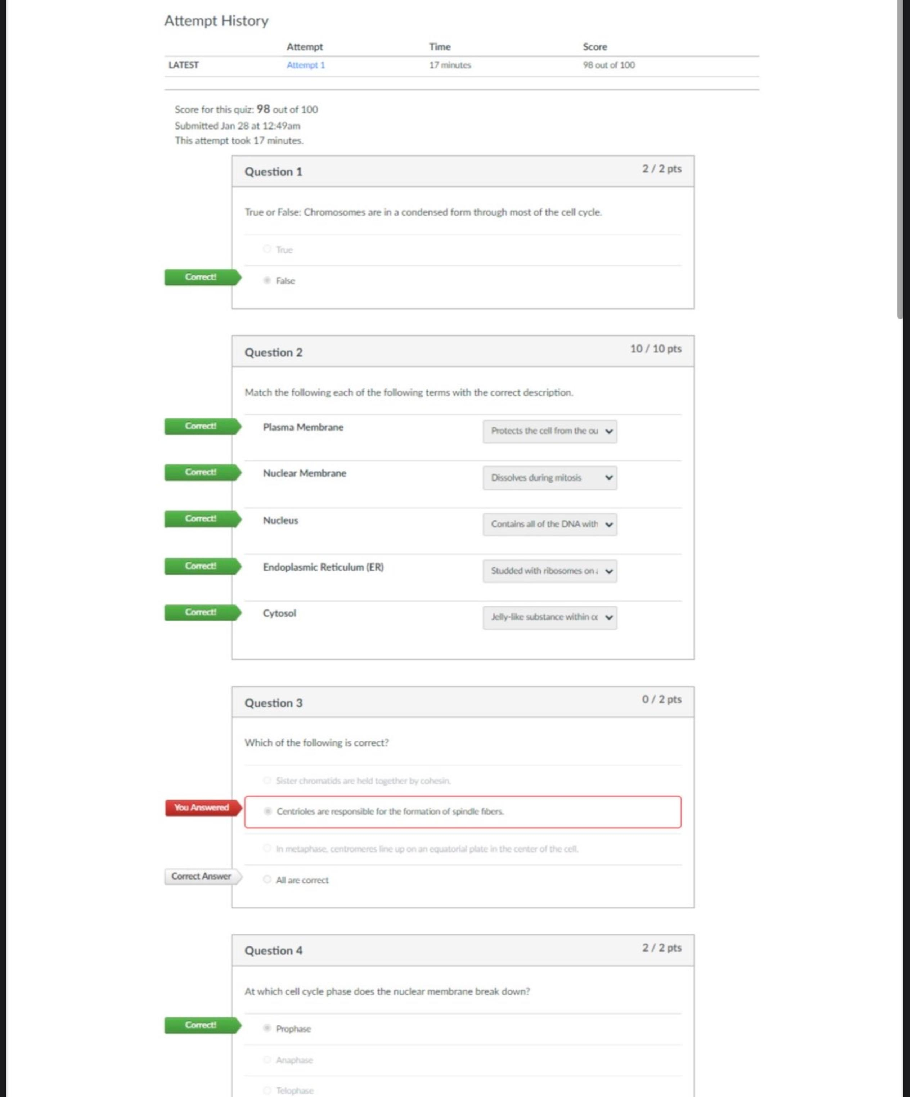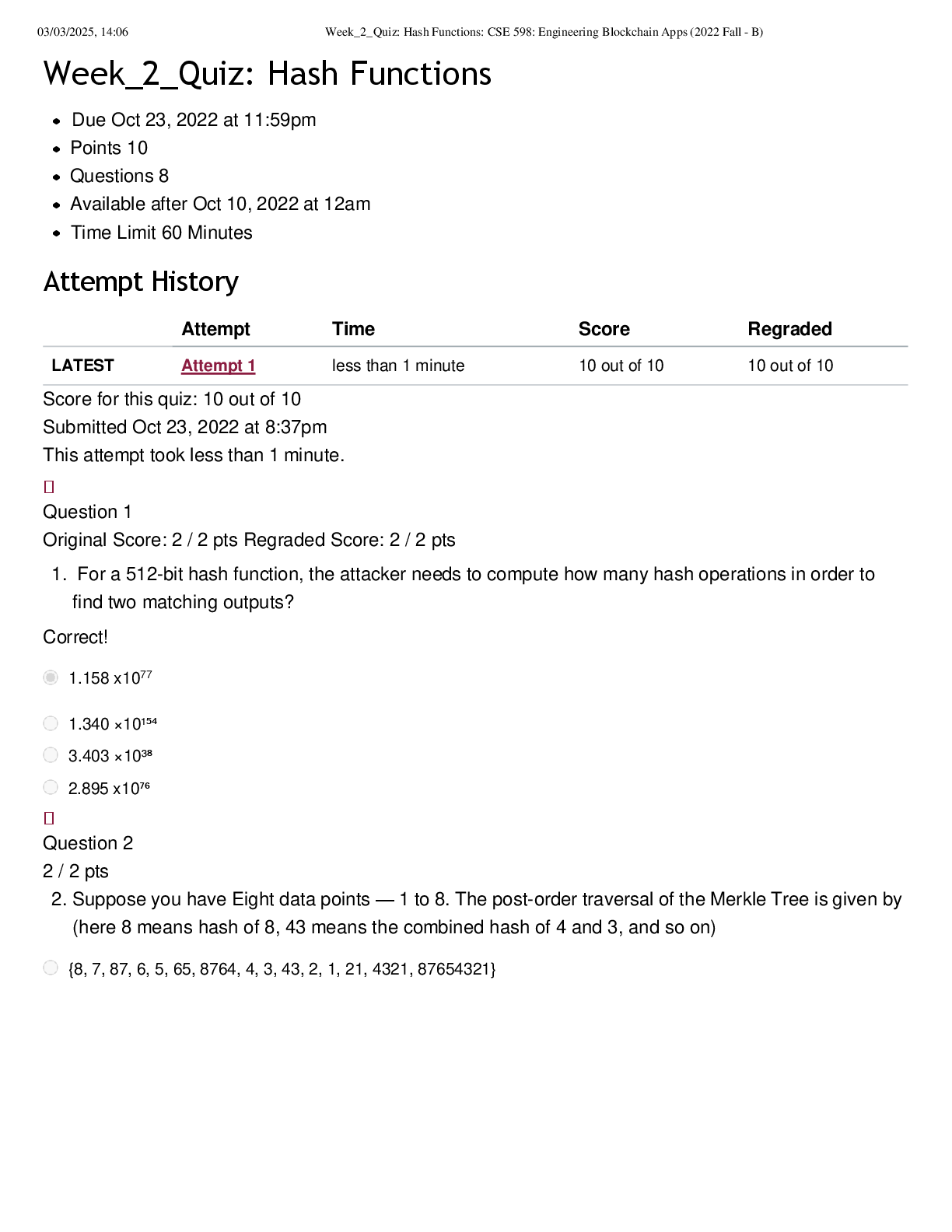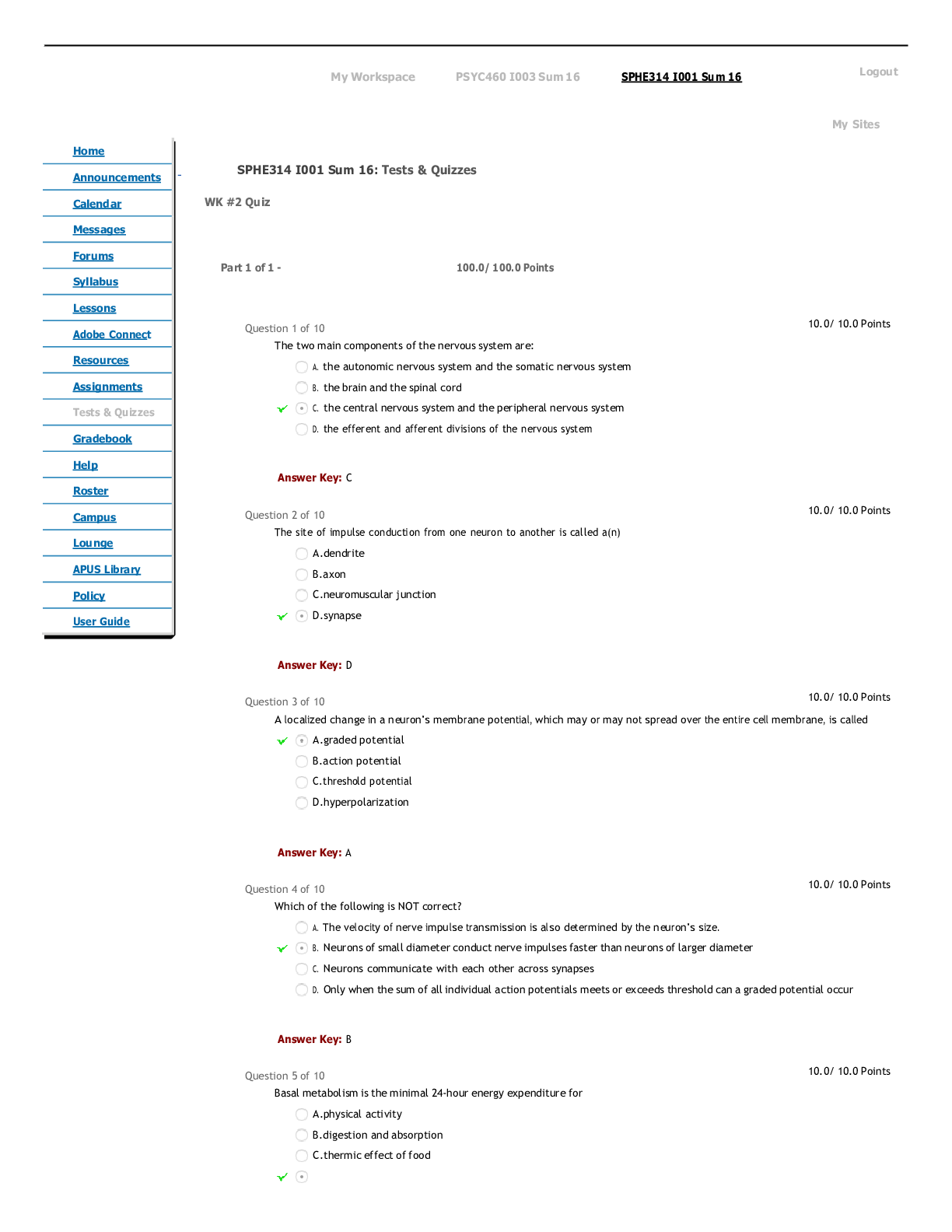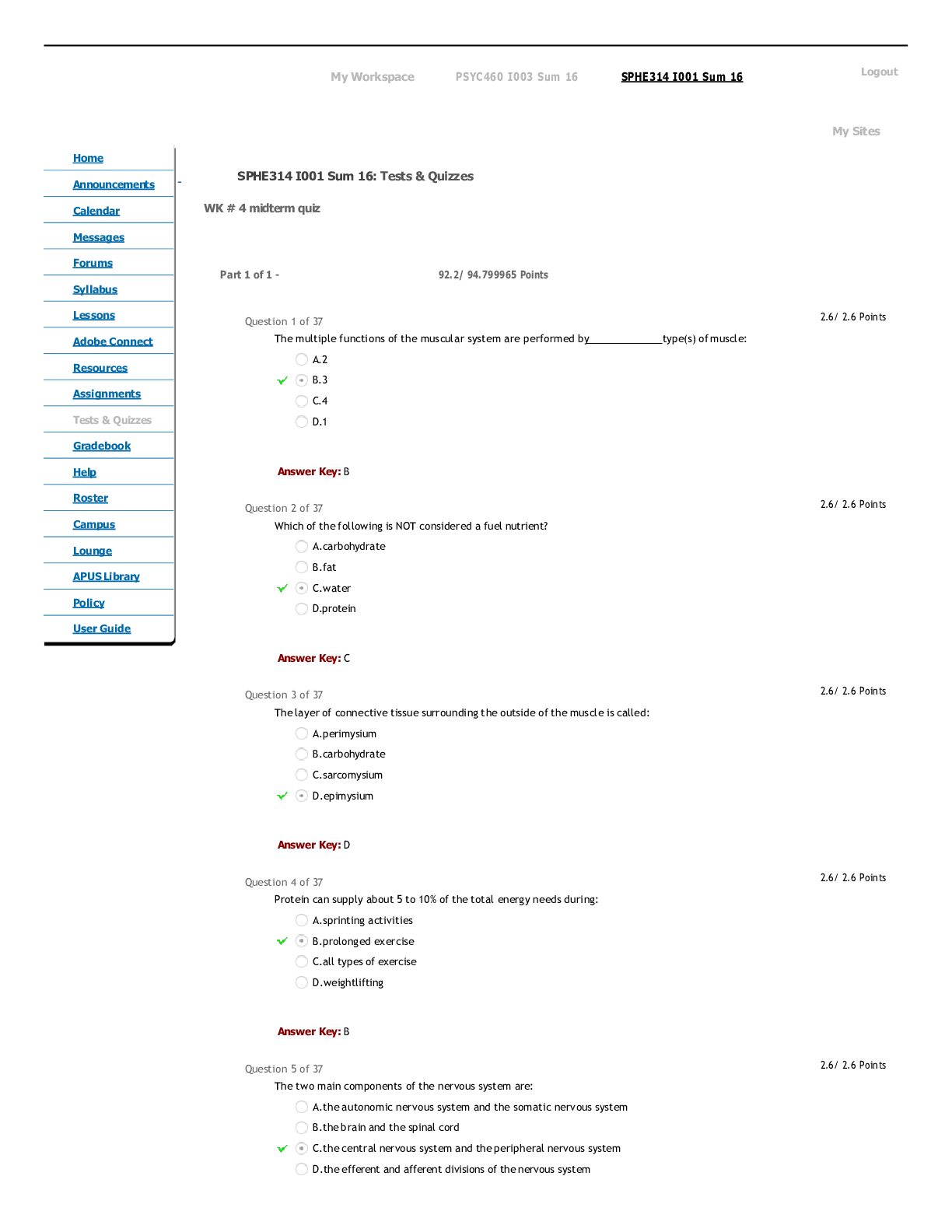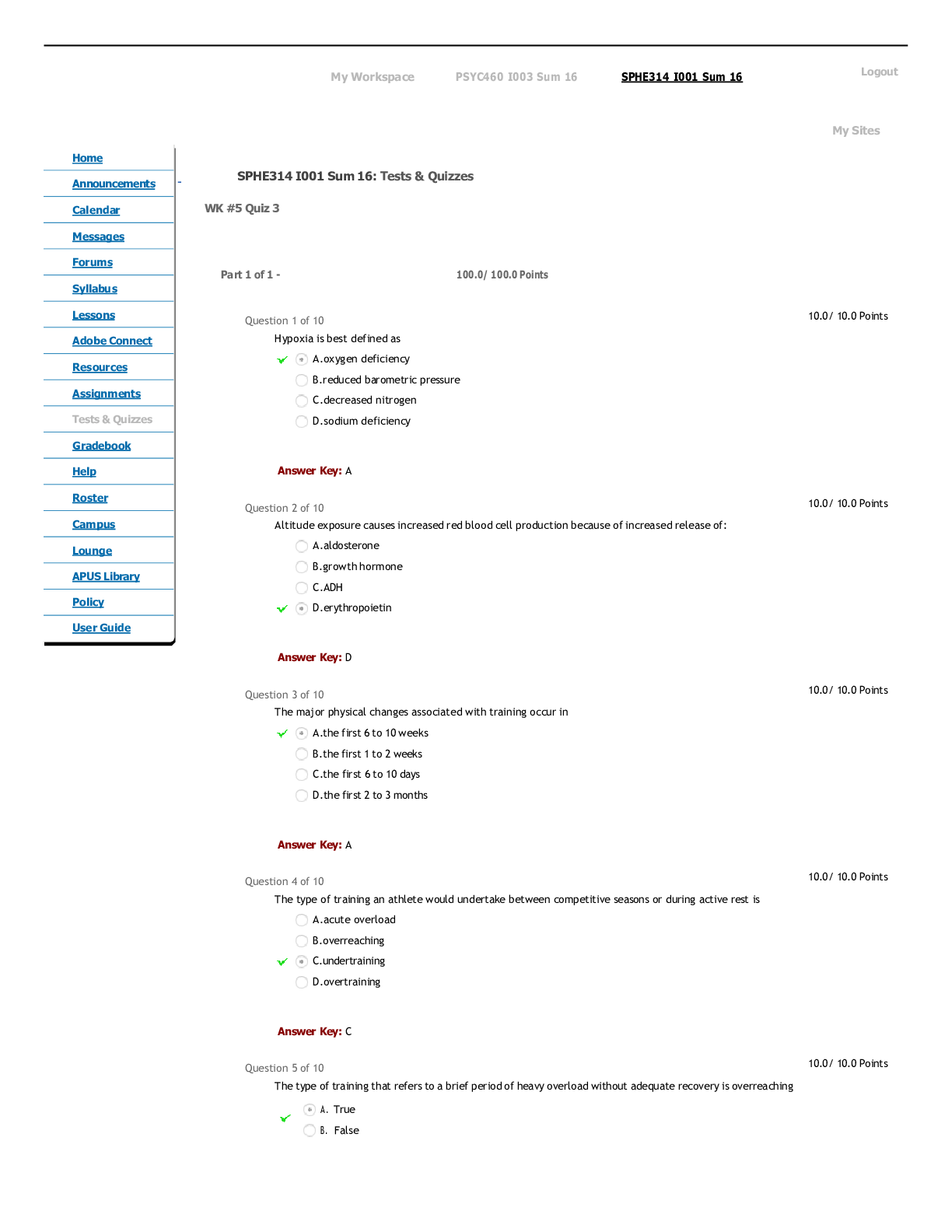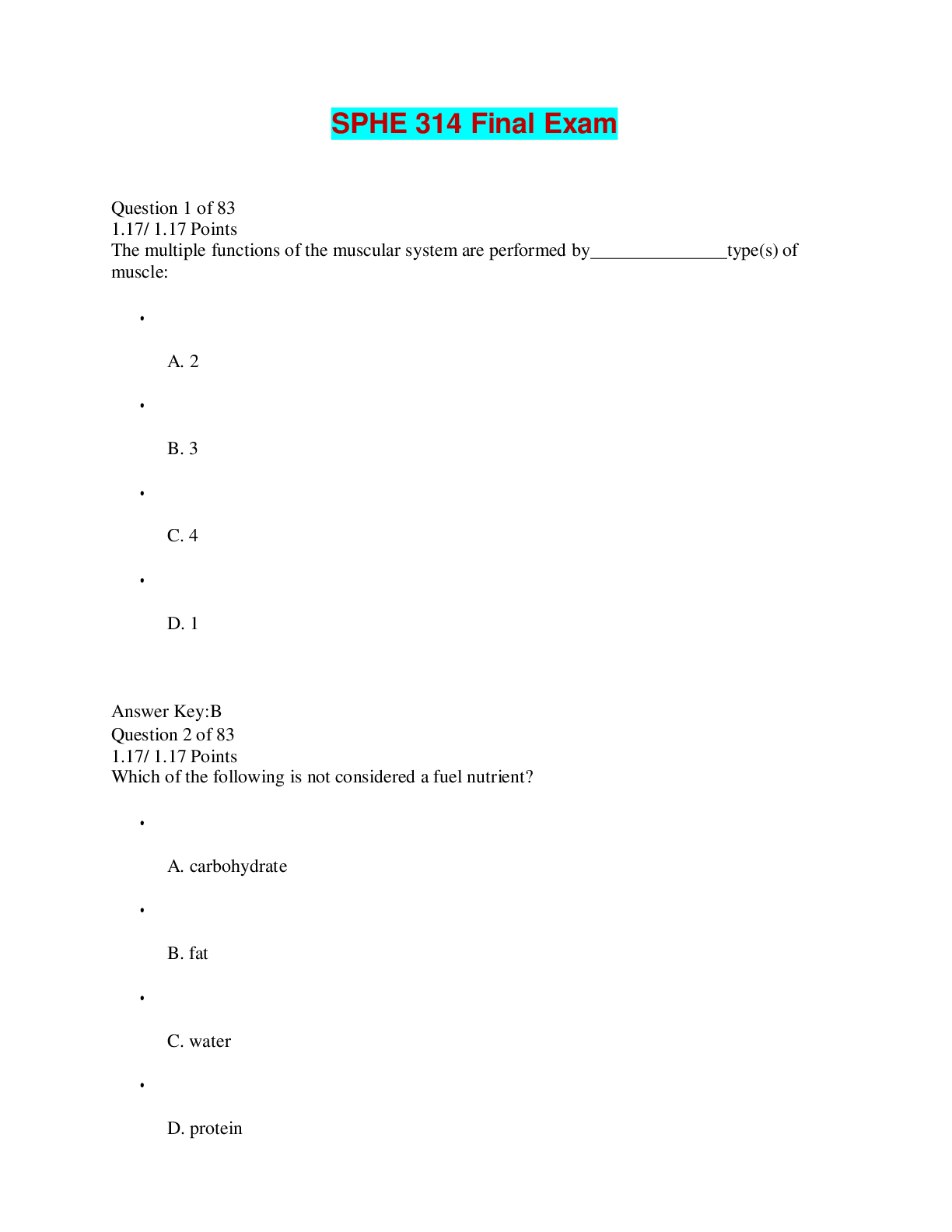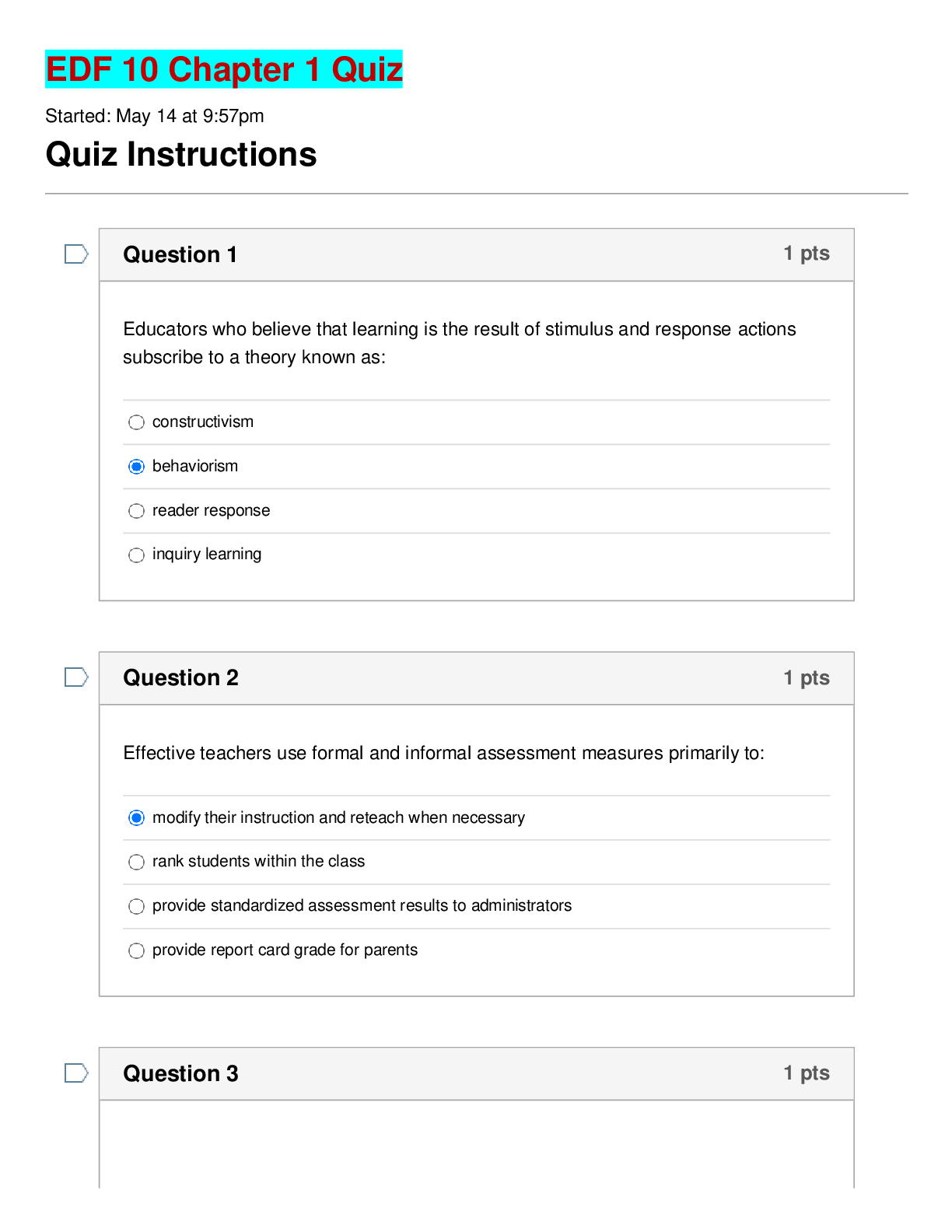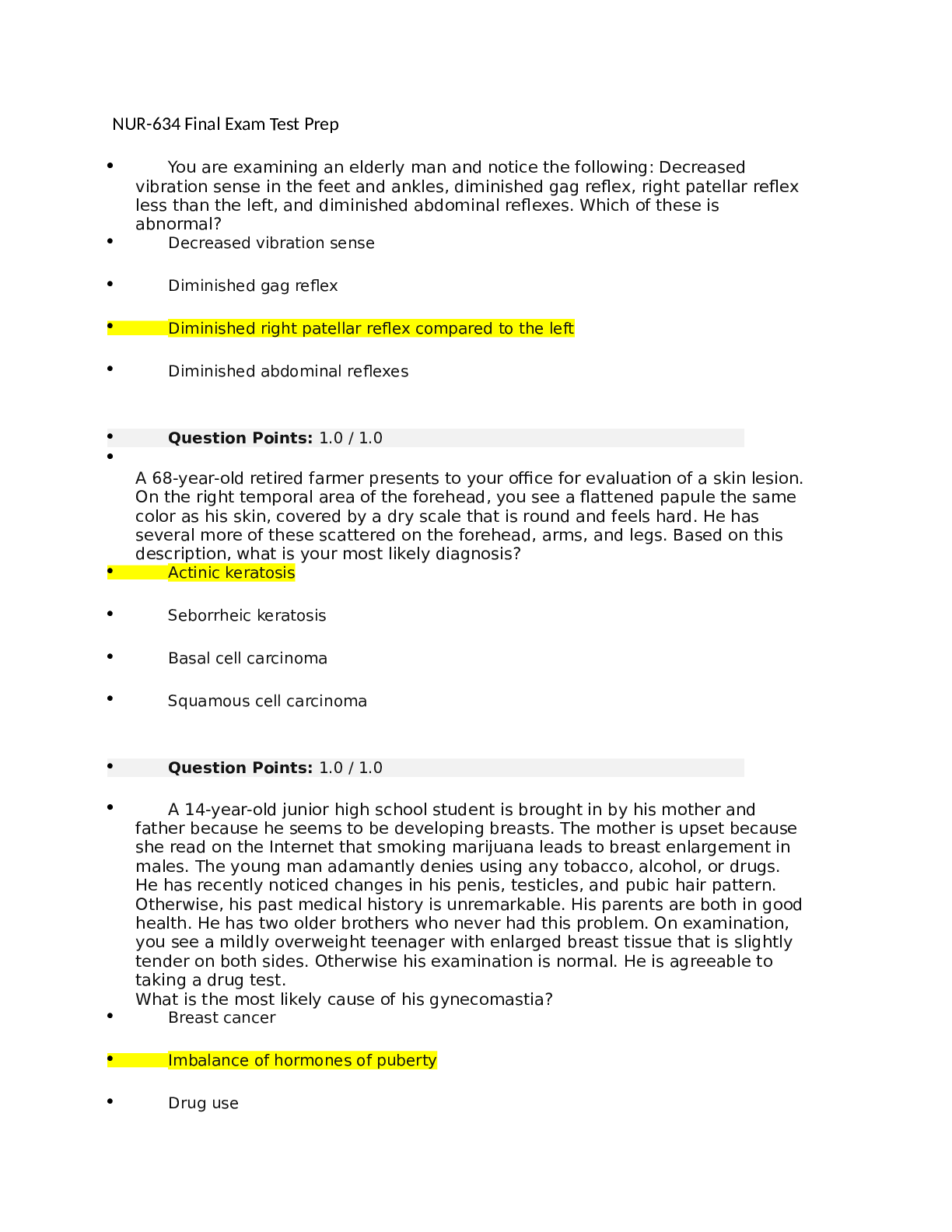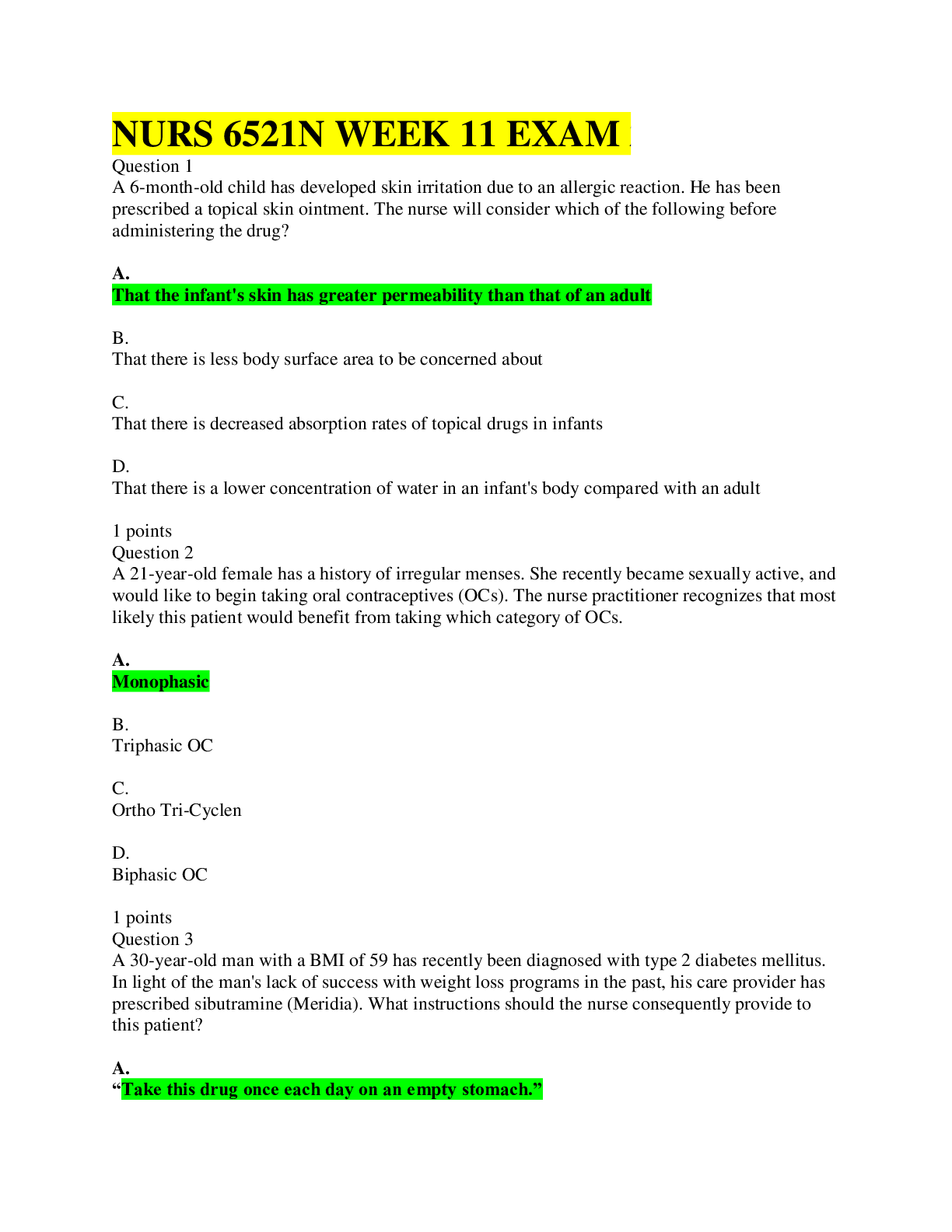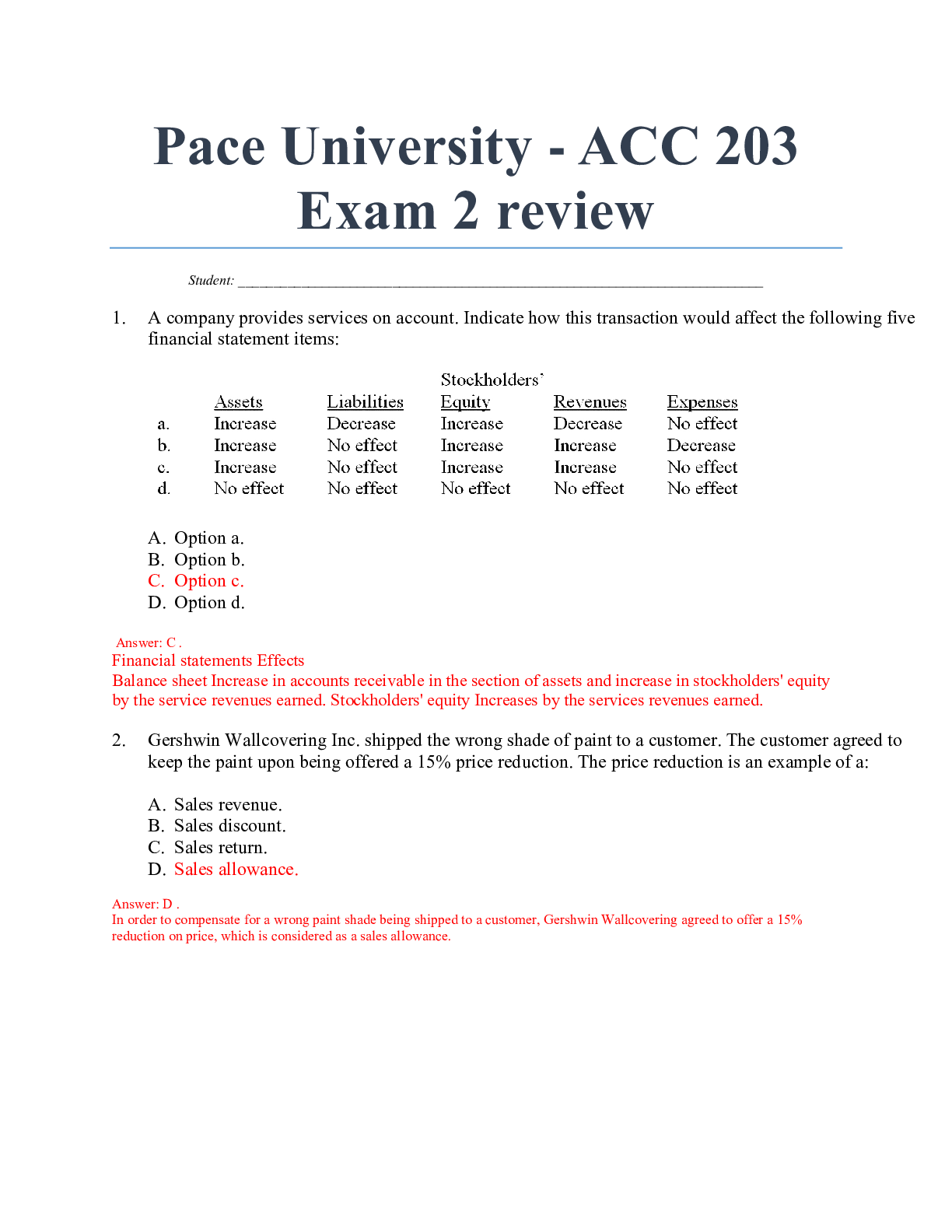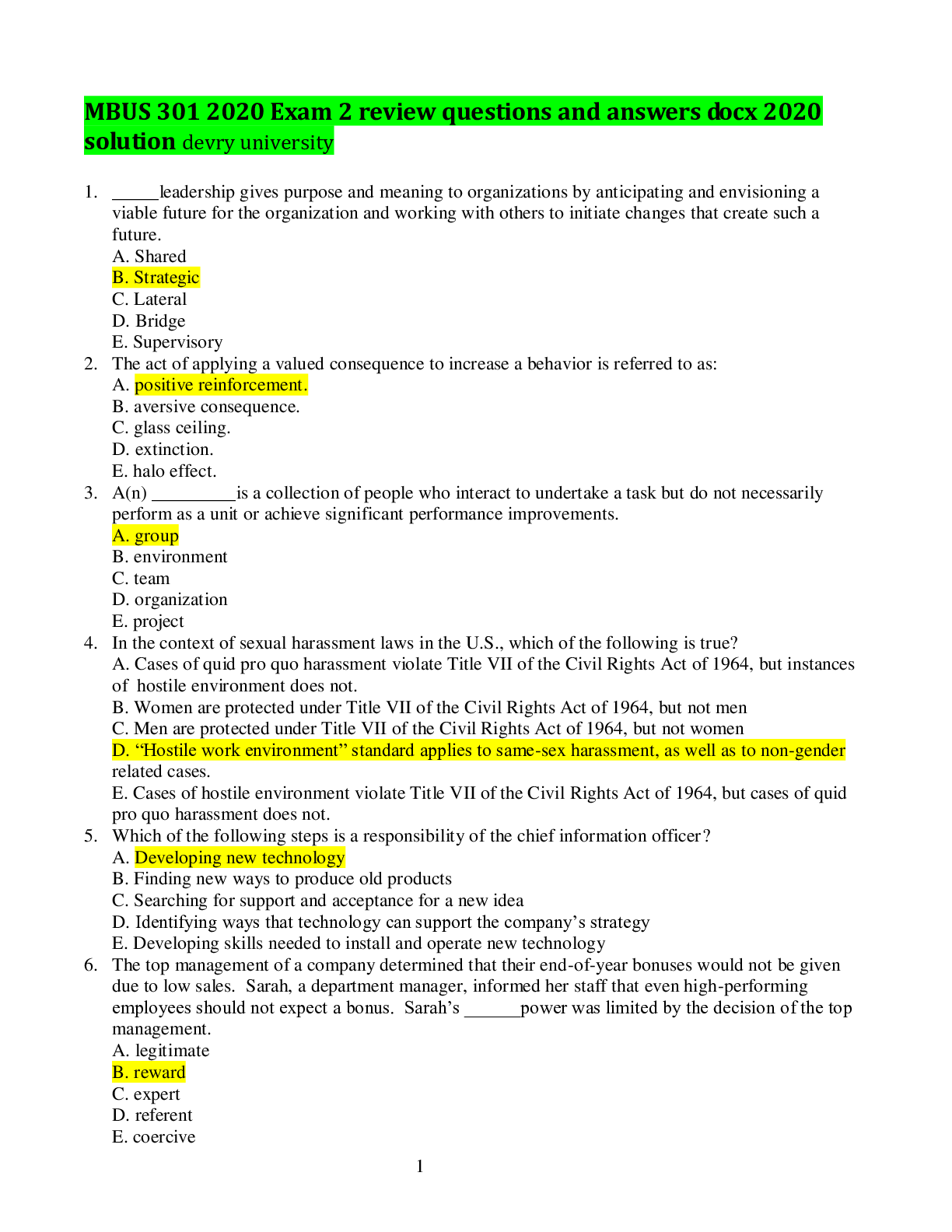BIO 436 Exam 2 Review | Questions and Answers (Complete Solutions)
Document Content and Description Below
BIO 436 Exam 2 Review | Questions and Answers (Complete Solutions) What is a specific junction where smaller cardiac cells are linked together? Intercalated Discs What have many desmosomes interspe... rsed within gap junctions? a. skeletal muscle b. intercalated discs c. pacemaker cells d. syncitium What are proteins on inside of most cells and proteins extend outward through the cell membrane and they twist along one another like velcro? Desmosomes What form tight connections between cells so they don't pull apart? Desmosomes What link pacemaker cells together and are made up of proteins called connexions? Gap junctions What form passageways for things such as sodium to diffuse directly into the interior or cytoplasm of adjacent cell? a. gap junctions b. desmosomes c. intercalated discs d. connexins What are cells linked together via gap junction that act as one large cell? Syncitium What can link thing things like sodium across gap junctions, that forms a way in which cells get adjacent and can become polarized? a. gap junctions b. desmosomes c. intercalated discs d. syncitium What will receive depolarization events from the pacemaker cells, causing activity to come from within the muscle itself (unlike neurons for skeletal muscle)? Myogenic What has the sole function to continually start depolarization and allow it to spread to other pacemaker cells and to adjacent contracting cells? Pacemaker cells What protein do Pacemaker cells produce? HCN channel (Hyperpolazied activated cyclic-nucleotide channels) True or False: Pacemaker cells have a resting membrane potential because as soon as they hyperpolarize, HCN channels will open and they will depolarize up to threshold. False NEVER have resting membrane potential When pacemaker cells reach threshold, they have ______________________________ channel that allows _________________ in and cell to depolarize quickly, shut off, and the ________________ open. Voltage gated Ca2+ channel Calcium Voltage Gated K+ channel What shows the fastest rate of spontaneous depolarization? SA node What is a pacemaker cell that sets the heartbeat frequency? a. AV node b. SA node c. Bundle of HIS What is initiated by Na+ flowing through channel that opens when hyperpolarized via HCN channels? SA node What is an enlarged pouch that adjoins the heart, is formed by the union of the large systemic veins, and is located in the right atrium housing the coronary sinus and the SA node? Sinus venous What is a pacemaker cell that, as the electrical activity is spread throughout the atria, travels via these specialized pathways from the SA node to the AV node? a. SA node b. Internodal pathway/fibers c. AV node d. Bundle of HIS e. Purkinje Fibers What is pacemaker cell with an electrical relay stations between the upper and lower chambers of the heart that carries electrical signals from the atria to the ventricles? a. SA node b. Internodal pathway/fibers c. AV node d. Bundle of HIS e. Purkinje Fibers What is a pacemaker cell that controls HR and is an electric relay station, slowing the SA node signal (delay - allowing atria to contract fully before ventricles are stimulated)? a. SA node b. Internodal pathway/fibers c. AV node d. Bundle of HIS e. Purkinje Fibers What is a pacemaker cell that is a collection of heart muscle cells specialized for electrical conduction that transmits the electrical impulses from the AV node (located between the atria and the ventricles) to the point of the apex of the fascicular branches via the bundle branches? a. SA node b. Internodal pathway/fibers c. AV node d. Bundle of HIS e. Purkinje Fibers What is a pacemaker cell that are any of the specialized cardiac muscle fibers, part of the impulse-conducting network of the heart, that rapidly transmit impulses from the AV node to the ventricles? a. SA node b. Internodal pathway/fibers c. AV node d. Bundle of HIS e. Purkinje Fibers What is the slow, positive increase in voltage across the cell's membrane (the membrane potential) that occurs between the end of one action potential and the beginning of the next action potential? Pacemaker Potential Which of these neurotransmitters parasympathetic postganglionics also release ACh? a. Cholinergic synapses b. Adrenergic synapses Which of these neurotransmitters most Sympathetic post-ganglionics release Norepi (noradenaline)? a. Cholinergic synapses b. Adrenergic synapses Which of these binds to receptors that ACh will bind and they can either inhibit or mimic the action of ACh? a. Cholinergic drugs b. Adrenergic drugs Which of these binds to receptors that bind either NE or EPI, therefore these drugs would effect the sympathetic NS (these can also inhibit or mimic actions of NE or EPI)? a. Cholinergic drugs b. Adrenergic drugs What is the general term of a drug that mimics the action of the natural ligand? Agonist What is the general term of a drug that inhibits the action of the natural ligand? Antagonist Without neuronal influences, SA node will drive heart at rate of its spontaneous activity. This is known as _________________________. Autorhythmicity What is the heart's ability to trigger its own contractions called? Autorhythmicity What is Cranial nerve X, which carries the signal to the heart? Vagus nerve Excess stimulation of the __________________ nerve will cause heart to stop beating, parasympathetic control, slows heart. Vagus In what phase of membrane polarization does the membrane remain in a depolarized state, Potassium channels stay closed, and long-lasting calcium channels stay open? Phase 2; Plateau Phase How long does the Plateau phase last in the membrane depolarization in a Cardiac Action Potential? 200 ms or 0.2 seconds What are Extra, abnormal heartbeats that begin in one of your heart's two lower pumping chambers (ventricles). These extra beats disrupt your regular heart rhythm, sometimes causing you to feel a flip-flop or skipped beat in your chest? Pre-Ventricular Contraction Describe Pre-Ventricular Contractions. An extra heartbeat in one of the ventricles that disrupts your heart rhythm and makes you feel a skipped beat. What is sympathetic, speeds up heart, stimulate opening of pacemaker HCN channels? Epinephrine What depolarizes SA faster, increasing HR, and increases frequencies of AP? Epinephrine What helps keep HR stable after a heart attack or during surgery and lowers amount of body fluids inside your mouth and throat before surgery? Atropine What increases HR and prevents low HR, especially during surgery? Atropine When are the HCN channels activated? a. When the membrane depolarizes b. when the membrane repolarizes c. when the membrane hyperpolarizes d. a and b e. b and c NA+ flowing through channels that open when hyper polarized causes Spontaneous depolarization via? HCN channels In a cardiac action potential, at threshold _________________ channels open creating an upstroke. Voltage gated Ca2+ channels Repolarization in a cardiac action potential is via the opening of the _______________ channel. Voltage Gated K+ channel The pacemaker potential happens around which phase of the cardiac action potential? Hyperpolarization Which hormone increase the frequency of APs? Epinephrine Which hormone decreases the frequency of APs? Ach How does ACh decrease the frequency of AP? Binding to muscarinic cholinergic receptors embedded in the plasma membrane of the SA node cells. Then, WhenIndirectly opens K+ channels, and closes Ca++ and Na+ channels, decreasing the rate of depolarization and, thus, decreasing HR. When you open K+ channels, you are starting what phase of the cardiac action potential? Repolarization Name similarities of Skeletal muscles and Cardiac Muscles. -both have sarcomeres Name differences of Skeletal and Cardiac Muscles -Cardiac muscles are smaller - Cardiac muscles have intercalated discs instead of long fibers or cells that wrap around - Majority of Calcium in Skeletal muscle comes from the SR, while in Cardiac cells majority comes from channels that allow Ca2+ to diffuse - Skeletal muscles require neuron to be activated, while cardiac muscles have pacemaker cells (they are myogenic) What is the amount of blood pumped out by each ventricle in one minute? Cardiac Output Cardiac output is directly related to what? heart rate and stroke volume. (ml/min or l/min) What is the number of times the heart beats in one minute, averaging 70-75 beats per minute (bpm) in the adult at rest? Heart Rate What is the amount of blood pumped by each ventricle with each heartbeat, averaging 70 ml per beat in the adult at rest? Stroke Volume What is the volume of blood in ventricles at end of diastole? End Diastolic volume Volume ejected by a single ventricular contraction. Blood ejected by the heart? Stroke Volume Stroke volume is determined by what three variables? EDV TPR and contractility The strength of ventricular contraction (increased by sympathetic activity) is known as ? Contractility The impedance to blood flow in arteries is called the Total Peripheral Resistance Volume remaining in the ventricle after contraction is called End Systolic Volume (ESV) Contractility is ________________ by sympathetic activity. Increased Muscular tissue of the heart is called? Myocardium What does this describe? The more blood that returns to the ventricles will result in more blood being pumped out of the ventricles. This is because, as more blood fills the ventricles, it stretches the heart muscle, stretching the sarcomeres of the myocytes a little more. This gives the sarcomeres more separation at rest and therefore more ability to overlap when they contract, producing a stronger contraction and more ejection of blood. Cardiac Cycle What pumps blood out, contraction of the heart, and 60% of the blood contained within the heart is ejected from the heart? Ventricular Systole This occurs in early systole, during which the ventricles contract with no corresponding volume change. This short-lasting event takes place when both the AV valve and SL valve are closed. Isovolumetric contraction What is an interval in the cardiac cycle, from the aortic component of the second heart sound, that is, closure of the aortic valve, to onset of filling by opening of the mitral valve? It can be used as an indicator of diastolic dysfunction Isovolumetric relaxation What is the Ejection of blood from ventricles of heart? Ventricular Ejection What is the artery carrying blood from the right ventricle of the heart to the lungs for oxygenation? Pulmonary artery What is a vein carrying oxygenated blood from the lungs to the left atrium of the heart? Pulmonary vein The more blood that returns to the ventricles will result in more blood being pumped out of the ventricles. This is because, as more blood fills the ventricles, it stretches the heart muscle, stretching the sarcomeres of the myocytes a little more. This gives the sarcomeres more separation at rest and therefore more ability to overlap when they contract, producing a stronger contraction and more ejection of blood. Frank Starling Law of the Heart What is the rate of blood flow back to the heart. It normally limits cardiac output? Venous return What are the blood vessels, including small arteries, arterioles, and metarterioles that form the major part of the total peripheral resistance to blood flow. Resistance vessels What is caused by sympathetic nervous system, increases resistance, decreases blood flow. Contraction of smooth muscle of the blood vessel. Decreases blood vessel radius? Vasoconstriction What decreases resistance, increases blood flow. Relaxation of smooth muscle of the blood vessel and causes an increase in the blood vessel radius? Vasodilation What are the veins that hold most of blood in body (70%) Have thin walls & stretch easily to accommodate more blood without increased pressure (higher compliance) - only 0-10 mmHg? Capacitance veins The accommodation of more blood without increased pressure is known as? Higher compliance What describes when blood is moved toward heart by contraction of surrounding skeletal muscles, pressure drops in chest during breathing? Skeletal muscle pump What are the main sources of total peripheral resistance? Main sources: Vessel diameter, blood viscosity, total vessel length Describes factors affecting blood flow and describes the relationship between blood pressure, vessel radius, vessel length, and blood viscosity on laminar blood flow. (πΔPr4)/(8Lη) Poiseuille's Law What Determines how much blood flows through a tissue or organ? Vascular resistance What effect do vasoconstriction and vasodilation have on vascular resistance? Vasodilation decreases resistance, increases blood flow Vasoconstriction increases resistance, decreases blood flow What is the difference between the arterial and the venous pressure that drives blood through the capillary beds of our organs? Mean arterial pressure (MAP) What is the equation for MAP? MAP = Diastolic pressure + 1/3 Pulse Pressure (PP) What is the equation for pulse pressure? PP = systolic pressure - diastolic pressure Arteries cannot expand and therefore create more resistance and higher pressures and Lost elasticity causing what? Arteriosclerosis Plaques in arteries that increase resistance, decrease flow rate, type of arteriosclerosis, leads to heart disease and is called? Arteriosclerosis Flow rate inversely proportional to ___________________. Resistance What can give us an idea if damage to heart wall "myopathy"? ECG/EKG What is an electrical activity record of the heart, using surface electrodes (can be done on any animal)? ECG/EKG The number of cells/volume in blood is known as the? Hematocrit What is a separation of electrically charged regions, so momentarily, one region can be polarized, another region depolarized? Dipole Can Pacemaker cell activity be seen in an ECG? No Can depolarization and repolarization of contracting cells bee seen on an ECG? Yes they produce a large enough signal to observe on ECG What is the MI in the heart? changes the dipole of the heart List the steps of the electrical pathway of the heart. SA node Internodal pathways AV node AV bundle (Bundle of HIS) Bundle branches Purkinji fibers What represents Atrial depolarization in an ECG? P wave What represents AV nodal delay (1/10th of second)? PR segment What represents Ventricular depolarization (AND atria repolarization simultaneously)? QRS Complex What represents the time during which ventricles are contracting and emptying? ST segment What represents Ventricular repolarization? T wave What represents the time during which the ventricles are relaxing and filling? TP interval What part of the ECG lasts 200ms? P wave What part of an ECG lasts 0.12-0.20 seconds? [Show More]
Last updated: 6 months ago
Preview 5 out of 24 pages

Loading document previews ...
Buy this document to get the full access instantly
Instant Download Access after purchase
Buy NowInstant download
We Accept:

Reviews( 0 )
$16.00
Can't find what you want? Try our AI powered Search
Document information
Connected school, study & course
About the document
Uploaded On
Dec 05, 2024
Number of pages
24
Written in
Additional information
This document has been written for:
Uploaded
Dec 05, 2024
Downloads
0
Views
15

